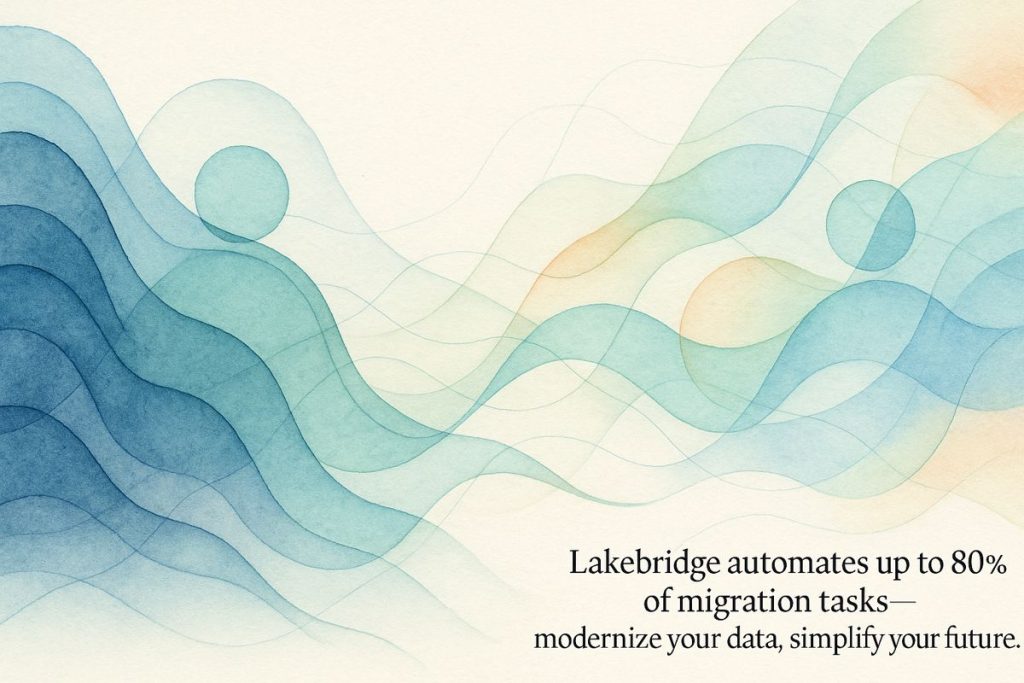Databricks Lakebridge is a free, open-source tool that helps companies move their old data warehouses, like Teradata or Oracle, into the modern Databricks Lakehouse. It automates difficult tasks such as schema discovery, SQL translation, and validation, making migrations easier and more cost-effective. Built in modular parts for assessment, analysis, transformation, and validation, Lakebridge simplifies complex data migrations, despite the continued need for handling custom code.
What is Databricks Lakebridge and how does it help with data warehouse migrations?
Databricks Lakebridge is a free, open-source tool designed to simplify enterprise data warehouse migrations to the Databricks Lakehouse. It automates profiling, analyzing, converting, and validating legacy database objects, translating SQL dialects and streamlining the migration process for Teradata, Oracle, and Microsoft SQL Server environments.
Setting the Scene: Data’s Changing Tides
Databases age like cheese left under a radiator—sometimes pungent, rarely appetizing. Enterprises everywhere, especially those who still whisper the names Teradata or Oracle in hushed tones, have long yearned for a sleeker, more scalable way to wrangle their data. Enter the Databricks Lakehouse: think of it as a palimpsest where old data warehouse hieroglyphics are translated into modern, Spark-powered poetry. And to help move the ancient tablets? Databricks’ new open-source tool, Lakebridge—a kind of hyperspectral migration compass for the cloud era.
I’ll admit, when I first saw the announcement (see SiliconANGLE), my inner skeptic hummed like a misaligned server fan. Free and open-source? Claims of automating 80% of migration? I’ve seen such numbers tossed around like confetti at a Moscow wedding. But Lakebridge, as I soon discovered, isn’t vaporware. It’s a real, command-line companion, crafted by Databricks Labs for the unsung heroes in IT—the folks who stare down legacy schemas with the stoicism of Dostoevsky’s Ivan Karamazov.
Inside Lakebridge: The Modular Mechanism
Lakebridge is split into modules, each humming along with its own purpose. There’s Profiler—a kind of digital ethnographer that mines your old database for table structures, view definitions, and usage patterns. I once ran Profiler on a client’s Oracle warehouse and, like a truffle pig, it unearthed hidden views last queried in 2012. The nostalgia was almost tangible, like the faint smell of burnt coffee at 3 a.m.
Then comes Analyzer, the tool’s analytic cortex. It scans and classifies not just tables, but the gnarled undergrowth of stored procedures and ETL jobs. By sorting objects by complexity, it lets teams prioritize the heavy-lifting—think of it as the Marie Kondo for your data warehouse attic. I had to stop and ask myself: Did I really need that twelve-layer nested view, or was it just data hoarding masquerading as architecture?
Finally, the Converter steps up. This is where the magic (or at times, the black magic) happens. Converter translates SQL dialects—Teradata BTEQ, Oracle PL/SQL, Microsoft T-SQL—into Databricks SQL or Apache Spark SQL. Rules-based, yes, but sometimes you hit the procedural logic equivalent of a Gordian knot. When that happens, manual intervention is required; I’ve learned this the hard way, though at least now I approach such knots with less trepidation and more caffeine.
Oh, and there’s a Validator, too, making sure what comes out of the pipeline matches what went in—no missing data, no ghostly business logic. Built-in dashboards and reconciliation tools make the whole process feel less like navigating a labyrinth and more like following a neatly drawn map (with a few dragons noted in the margins).
Lakehouse or Bust: Why Even Move?
So why all the fuss about migrating to the Databricks Lakehouse? It’s more than a shiny new toy. Lakehouse architecture, as detailed in Databricks documentation, fuses the flexibility of data lakes with the sturdy, performance-minded backbone of a traditional warehouse. It’s where structured, semi-structured, and unstructured data mingle, all under the watchful eye of unified governance and security protocols.
You get schema evolution, data versioning, and the power to run both batch and real-time analytics. And yes, the cost efficiencies—rooted in open-source, cloud-native tech—can make even the most jaded CFO smile. There’s an unmistakable sense of promise (and, okay, a twinge of anxiety) when watching legacy workloads take their first baby steps in this new ecosystem.
Does it always go smoothly? Nope. I recall one migration that left me pacing the office, muttering under my breath as cryptic error codes flashed by like a strobe light at a Berlin nightclub. Yet when it clicks—bam!—there’s real satisfaction, the sort you get from assembling a stubborn IKEA bookcase without swearing.
The Broader Web: Partnerships, Practicalities, and Pitfalls
Lakebridge doesn’t float alone in the dataverse. It’s part of the larger Databricks ecosystem, buttressed by consulting titans like Capgemini, Deloitte, Infosys, and Avanade. These folks have seen enough migrations to write a saga, and their migration accelerators can be a godsend when you’re up against tight deadlines or Byzantine multi-cloud environments. For more on this, consult the Lakebridge official page.
But let’s not sugarcoat it: Lakebridge isn’t turnkey. You’ll still need to roll up your sleeves, especially when dealing with bespoke ETL jobs or esoteric procedural code. Pattern matching only gets you so far. At the end of the day, it’s a tool—not a miracle worker. The community’s steadily expanding its capabilities, though, and watching those incremental pull requests land gives me a peculiar thrill. Maybe that’s just the programmer’s version of Stockholm syndrome…
For more resources, I highly recommend:
– Lakebridge Alternatives on Datafold
– Databricks Lakehouse vs Data Warehouse on ChaosSearch
The Takeaway: A Living Bridge
Data migrations are rarely poetry, but with Lakebridge, at least you get a decent thesaurus. Is it perfect? Of course not. But it’s free, open, and, with enough coffee, almost enjoyable. The texture of a successful migration—equal parts relief and exhilaration—lingers long after the dashboards stop blinking. And isn’t that what progress smells like? Burnt coffee and new beginnings.
